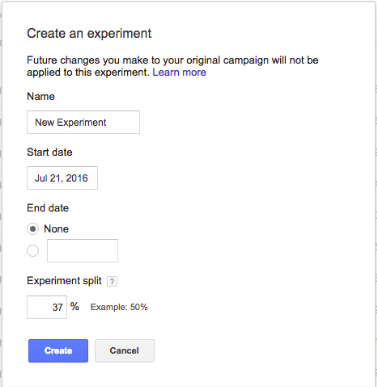By: Rachel Zinanti & Maggie Castle
To make the change, or not make the change? You think it will be great for the account, but what if it’s not? What if it tanks and your SEM performance takes a nosedive?
If you manage paid search accounts, you know what we’re talking about. You’ve had this inner monologue. If only you could acquire data before making the update. Well, you can! There’s a tool in Google Ads called Experiments that helps you do just that.
We can sense your eyes rolling now. “Not this again.” Yes, Google Ads Experiments have been around for some time, but when you pair them with Drafts, your testing limits are endless. The entire settings tab is open to you – geos, bid modifiers, day parting, etc. Even ad extension testing is now possible. Having to limit the number of changes is a thing of the past. Plus, you have full control of how you want to split the traffic. Want to do a 37/63 split? Go for it!
Google Ads Drafts allow you to mirror a whole PPC campaign and then make changes independently of the original one. Once you’ve made your changes, you can apply your draft campaign as an experiment, and voilà! In just a few simple steps, you’re testing out the impact of a 50% mobile bid modifier compared to a 10% mobile bid modifier.
Here are some ideas of optimizations you can now efficiently test that you may have been holding back on launching:
- Ad Rotation (e.g., rotate evenly vs. optimize for conversions)
- Ad Extensions (e.g., performance of structured snippets vs. callouts)
- Restructures (e.g., ad group break out by match type)
- Keyword Reduction
- Day/Time Parting
- New Geographic Targeting
- Display Placement Exclusions
- Any Client Requests You’re Unsure Of
One test we recently conducted was comparing whether structured snippets or callout extensions had a greater impact on click-through-rate (CTR) and conversion rate (CVR) for branded keywords in an account.
In our experiment campaign, we ran callouts while our original campaign received structured snippets. All other extensions (sitelinks, call, and location) remained the same across the two campaigns. We ran a 50/50 split for four weeks and found that ads with callouts had a higher CTR (98% significant) and CVR (91% significant) than ads with structured snippets.
Our suggestion is that you use the data from your findings to decide if it makes sense to roll out changes to the whole campaign or not. If you like what you’re seeing, applying it to the original campaign is as simple as clicking a button.
As much as we love experiments with drafts, there are a few downsides. Notably:
- Original & Draft campaigns are independent of each other
- While this is the main positive for allowing testing to happen, it does make any standard optimizations (such as bid changes) more difficult as changes need to be made to each campaign separately to ensure that the comparison is valid.
- Data Stays In Drafts Section
-
- There is a total line item on the main campaign page that summarizes overall experiment data. If you want an overall view of how a specific campaign, ad group, or keyword performed, you’ll need to pull data from two areas and marry the data together.
-
While these challenges are a bummer, we’ve found that the insight we get from running experiments is worth the effort. So, in the future, when you’re faced with whether to make the change or not: head to this tool and let the testing begin!
Google Resources For Experiments & Drafts







